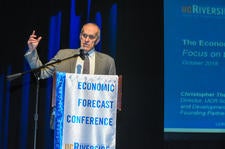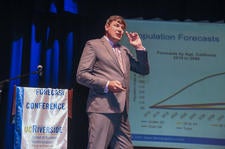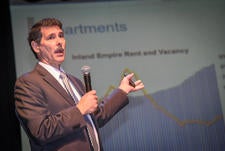
Business and academic leaders packed the historic Fox Theater in downtown Riverside for the ninth-annual Inland Empire Economic Forecast Conference on Oct. 11 to hear good news about the Inland Empire’s economy: Ten years after the recession of 2008 the region is home to the fastest job growth in Southern California and is the most improved among the major surrounding metropolitan areas of Los Angeles, San Diego, and Orange counties.
Following introductory remarks by UC Riverside Chancellor Kim A. Wilcox and UCR School of Business Dean Yunzen Wang, speakers from the School of Business Center for Economic Forecasting and CBRE Properties presented detailed analyses of how the region has changed in the past ten years and the directions they expect change to occur in the future.
During the Great Recession, the Inland Empire lost 150,000 jobs and nonfarm employment fell by nearly 11.6 percent.
Since bottoming out, however, the region has gained well over 350,000 jobs and nonfarm employment has increased 31 percent.
“When an economy falls further during a downturn, it generally experiences a stronger relative recovery, but economic growth in the Inland Empire has been gaining momentum in recent years and is being strongly driven by its sharp affordability advantage, which has led to significant population gains,” said Christopher Thornberg, director of the UC Riverside School of Business Center for Economic Forecasting. “And although there are longer-term threats to the economy that stem from labor shortages, federal trade policies, and our hugely expanded national debt, growth is expected to continue through the next year at the local, state, and national level.“
The Inland Empire also stands out because it is the most improved Southern California economy, according to the analysis. Compared to its prerecession peak, the Inland Empire today has 16.1 percent more jobs. This increase surpassed the rates of Los Angeles, Orange and San Diego Counties, which saw gains of 5.6 percent, 6.6 percent, and 10.6 percent, respectively. The nation saw an increase of 7.7 percent over the same span.
“The progress the Inland Empire economy has made over the past couple of years is the latest phase in a years-long growth wave that has included broad-based employment gains across most industries, higher income and more local spending, rising home prices, and, as of late, increased construction activity,” said Robert Kleinhenz, executive director of research at the center. “But growth is going to moderate in the relatively near future as a limited supply of workers will put a check on the region’s expansion.”
According to both Kleinhenz and Thornberg, there is a critical need to address California’s high housing costs and its labor shortages across skill levels in order to ensure healthy economic growth in the Inland Empire and beyond. Speakers from CBRE Properties, a commercial real estate firm, concurred that sustained growth will require additional investment in building new housing and business spaces.
Select Key Findings:
- The jobs forecast in the Inland Empire calls for continued gains, with total nonfarm employment expected to grow between 2.5 percent and 3 percent in the near term, while the unemployment rate will drop to less than 4 percent in 2019.
- The Inland Empire’s renowned logistics industry is the region’s most improved, having nearly doubled in size over the past decade, with employment 90 percent higher than it was at its pre-recession peak. The effects from the current trade tariffs, however, are yet to be seen.
- The region has also enjoyed gains elsewhere, notably in construction, health care, and retail trade, responding to continued growth in the region’s population and business activity.
- As of the second quarter of 2018, the median nominal price of an existing single-family home in San Bernardino County was 17.2 percent below its prerecession peak, while in Riverside County it was 9.7 percent less. If current trends continue, the forecast has nominal home prices in the region surpassing their prerecession peak in 2020.
- Growth in the U.S. economy looks solid for the rest of this year but will slow in 2019. Additionally, while there is no reason to expect a recession anytime soon, the long-term stressors of heavy federal borrowing, rising interest rates, and policy uncertainties, substantially diminish the nation’s capacity to absorb a blow to its economy; it won’t take much to end the current expansion.
- High housing costs will impede California’s economic growth over the long term to the extent they deter the state’s labor force from expanding. California’s labor force growth rate has slowed significantly since the fall of 2017, with year-to-year growth at just 0.2 percent as of July 2018.
The full report can be downloaded here.







